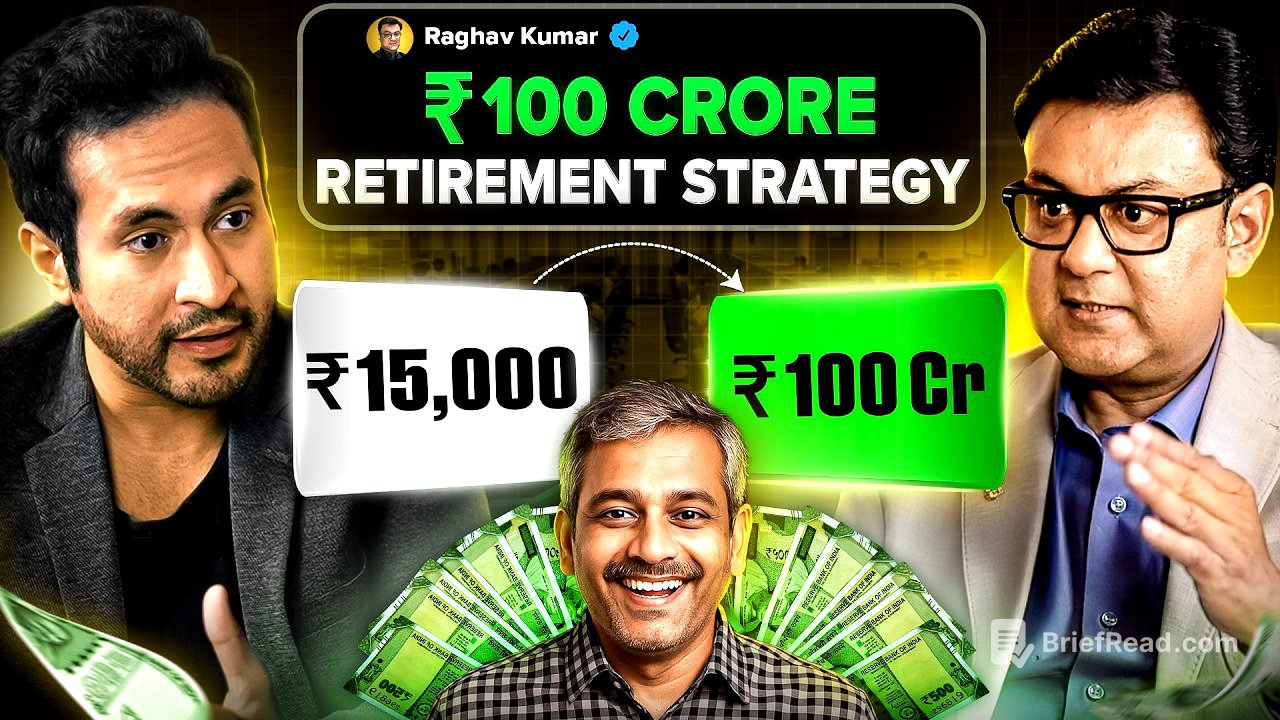TLDR;
Alright, so this video is all about cracking the code to that ₹100 crore mindset and taking action, with Raghav Kumar, a SEBI registered research analyst. They're breaking down how to ditch the "get rich quick" schemes and focus on solid, practical ways to build wealth. Key takeaways include:
- Believing it's possible to achieve big financial goals.
- Shifting from chasing "passive income" to focusing on "wealth creation."
- Understanding the power of compounding and long-term investing.
- Avoiding common mistakes like lifestyle inflation and over-leveraging.
- Diversifying investments and staying disciplined.
Intro [0:00]
The video kicks off by highlighting how the finance industry often sells unrealistic dreams, making money seem like a cakewalk. Raghav emphasizes the importance of choosing the right path to wealth creation, focusing on practical methods that offer a higher chance of success. The key is to shift your mindset and start believing that achieving significant financial goals is possible.
Mindset Shift [5:11]
Raghav stresses that the first step is to believe that achieving your financial goals is possible, no matter how unrealistic they may seem today. Set a target, whether it's ₹10 crore, ₹50 crore, or ₹100 crore, and commit to achieving it through realistic and practical means. He cautions against getting caught up in "dream selling" and losing sight of the path.
Common Man's Perspective [7:49]
The discussion shifts to whether a common man can save enough to retire with ₹1 crore or even reach ₹100 crore. Raghav asserts that it's absolutely possible and can be proven mathematically. He advises focusing on needs over wants, saving a portion of income (even if it's just 5% or 10%), and understanding that small savings can lead to financial greatness.
Wealth Creation Mindset [9:53]
Gaurav and Raghav discuss the difference between the wealth creation mindset and the common man's mindset. They highlight that "passive income" is often glorified, but true wealth creation happens through passive means, by putting your money to work. It's crucial to understand the difference between saving (keeping money aside) and investing (making money work for you).
Active vs Passive Income [11:35]
They clarify that income is always active, requiring your time and energy. Wealth creation, on the other hand, is passive. As you earn money, invest a decent percentage in wealth creation. Even if you're young and healthy now, your income may depreciate later, so it's essential to build a financial pillar that grows over time through compounding.
No Shortcut to Wealth Creation [15:22]
Raghav and Gaurav emphasize that there's no shortcut to wealth creation. It requires focus, consistency, and patience. They point out that even legendary investors like Warren Buffett took decades to build their wealth. The key is to solidify your mindset, focus on active income, and start wealth creation as early as possible.
Clear Path to Retirement Corpus [19:01]
Raghav provides a clear path to retiring with ₹1 crore or even ₹100 crore. He uses the example of investing ₹15,000 per month with a 15% return for 15 years to become a crorepati. He stresses that a 15% return is achievable and realistic, based on the historical performance of the Nifty 50 index.
Power of Compounding [22:16]
They illustrate the power of compounding by calculating the potential returns of investing ₹15,000 per month for 35 years with a 15% return. The result is a whopping ₹22-23 crores! Raghav emphasizes that even without scaling up the investment, a substantial retirement corpus is achievable.
Investment Options [26:04]
Raghav discusses various investment options, starting with the most basic: Fixed Deposits (FDs). He quickly dismisses FDs due to their low real rate of return after accounting for inflation and taxes. He then moves on to gold, properties, mutual funds, and stocks, highlighting the pros and cons of each.
Mutual Funds and Stocks [29:05]
Mutual funds and stocks are presented as the most accessible and liquid options for the average Indian. They're easy to buy and sell, have low investment sizes, and offer good appreciation. Raghav explains the concept of Nifty as a composite index representing the Indian economy and suggests investing in Nifty index funds as a safe option.
Types of Mutual Funds [32:05]
Raghav explains the different types of mutual funds, including small cap, mid cap, large cap, and thematic funds. He advises having some basic knowledge of mutual funds before investing and suggests diversifying investments across multiple funds. He also mentions the "buy on dips" strategy for index funds to beat the average return.
Simplicity in Investing [34:26]
Raghav emphasizes the importance of simplicity in investing, quoting Einstein's view that simplicity is the ultimate sophistication. He cautions against getting caught up in complex strategies and losing sight of the basic principles. He also highlights the importance of investing in the growing Indian economy.
FNO Trading [36:16]
Raghav cautions against getting involved in FNO (Futures and Options) trading, citing a SEBI study that shows 93% of FNO traders lose money. He emphasizes that FNO trading requires a very high level of skill and emotional maturity, and it's not suitable for the average investor.
Mutual Funds vs Stocks [39:02]
Raghav suggests that there is no need to select between mutual funds and stocks, both are attractive avenues. The choice depends on your skill set and understanding of financial markets. If you're not interested in stocks, mutual funds are a good option, as fund managers manage them.
Portfolio Concept [48:24]
Raghav introduces the concept of a portfolio as a collection of stocks that should add value and balance to your overall investment strategy. He cautions against randomly picking stocks based on tips or hearsay and emphasizes the importance of diversification to mitigate risk.
Scams and How to Avoid Them [51:55]
Raghav discusses how scams often involve promoting companies with hyped-up stories and inflated stock prices. He advises doing your own research, diversifying your portfolio, and saying no to emotional investing. He also cautions against trusting insider information and relying on public domain information.
Emotional Investing [56:11]
Raghav warns against emotional investing, where you break your principles and invest all your money in a single stock based on hype or greed. He emphasizes the importance of sticking to your investment strategy and diversifying your portfolio to avoid significant losses.
Blended Approach [59:14]
Raghav suggests a blended approach to wealth creation, where you focus on your active income and invest a significant percentage passively. He emphasizes that you don't have to become a full-time investor to create wealth.
Small Cap Preference [1:01:48]
Raghav reveals his preference for small cap companies, as they offer higher growth potential in a growing economy like India. He explains the concept of "multibagger" stocks, which have the potential to multiply many times over.
Multibagger Concept [1:02:30]
Raghav explains that a multibagger stock is one that can multiply its value many times over. He emphasizes that growth companies have the potential to grow manifold and that investing in them can lead to significant returns.
Small Cap vs Large Cap [1:07:16]
Raghav uses a cricket analogy to explain the difference between small cap and large cap investing. He emphasizes that the mindset and risk management strategies are different for each. He also highlights the importance of understanding the potential upside and downside of each stock in your portfolio.
Risk Management [1:09:17]
Raghav explains that risk management involves keeping profits high and losses low. He emphasizes the importance of capping losses and maximizing profits. He also highlights the importance of patience and good research in creating a balanced portfolio.
Holding Period [1:12:03]
Raghav recommends holding stocks for at least 5 years, especially small cap companies, to allow them time to expand their business and achieve market penetration. He advises focusing on the company's fundamentals and ignoring short-term price fluctuations.
Simple Strategy [1:12:47]
Raghav summarizes the strategy as purely mathematical and practical, involving identifying companies that can grow 4x, 5x, or 2x and diversifying your portfolio to mitigate risk.
Top 3 Mistakes [1:33:42]
Raghav identifies the top three mistakes youngsters make with their finances: late realization, lifestyle inflation, and using leverage. He emphasizes the importance of starting early, restricting lifestyle inflation, and avoiding speculative investments like FNO trading.
Golden Opportunity [1:38:24]
Raghav highlights that this decade is a golden opportunity for India and its youngsters. He emphasizes the importance of trusting in India's growth and aligning with it.
Missed the Bus? [1:40:26]
Raghav assures viewers that it's never too late to start investing. He advises those who feel they've missed the bus to start now, focus on disciplined investments, and forget about past losses.
Investment Strategy [1:42:58]
Raghav recommends a disciplined investment strategy, starting with understanding your risk appetite and mentality. He suggests mutual funds as a good starting point and advises starting with index funds if you're unsure which fund to invest in.
Final Message [1:48:43]
Raghav's final message is a wake-up call to understand the importance of financial discipline and take action. He emphasizes that nobody is going to do it for you and that you need to take the step yourself. He also highlights the importance of doing your work and scaling up your business to generate income for investing.









![Gautham Govindan | WHATSAPP IS ALL PRIVACY PRIVACY NOW!
.
.
.
.
[Standup comedy, standup India, jokes, WhatsApp, encryption, disappearing messages, feature] | Instagram](https://wm-img.halpindev.com/p-briefread_c-10_b-10/urlb/aHR0cHM6Ly9zY29udGVudC1pYWQzLTIuY2RuaW5zdGFncmFtLmNvbS92L3Q1MS43NTc2MS0xNS81MDMwNjE3NzlfMTg0NTkzMzAwMDEwNzY1NDRfMjk3NzQxMzUzMDg3MjIyMzg3MF9uLmpwZz9zdHA9Y21wMV9kc3QtanBnX2UzNV9zNjQweDY0MF90dDYmX25jX2NhdD0xMDMmY2NiPTEtNyZfbmNfc2lkPTE4ZGU3NCZfbmNfb2hjPXdpWU9TRUVoNWRrUTdrTnZ3R2F6QmI3Jl9uY19vYz1BZGxEd0JtQjRHdjYtdF9XS0NtWklmNzUzUW11aTVJTVAzbE4ySXh3alYtbm9lU3RZcTdJQlFuSXJUX1ZoYXVaMmVjJl9uY196dD0yMyZfbmNfaHQ9c2NvbnRlbnQtaWFkMy0yLmNkbmluc3RhZ3JhbS5jb20mX25jX2dpZD0wR1VETHdZWnVCcG5KWVp6LTZPblhRJm9oPTAwX0FmUXFWQmVBS052UFVRb3hqNWJJT29Ec2c3NVhSWW04LWJSSzZ6TFE1YTMzR0Emb2U9Njg4MDFBQ0M=.jpg)